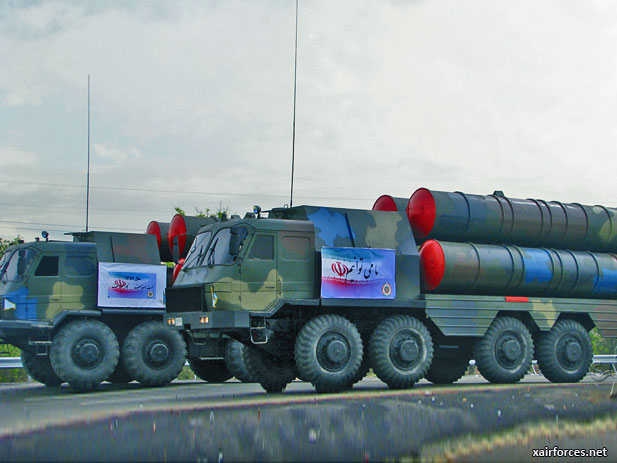
Iran General Claims Progress On New Air Defense System

The commander of Iran's air defense forces has said that Iran has completed about 30 percent of a new missile defense system.
Brigadier General Farzad Esmaili said on September 3 that he expects the Bavar-373 system to be completed by the end of next year.
He described the system as "more advanced" than Soviet-era S-300 surface-to-air missiles, saying they are better at "detecting, identifying and destroying targets."
The S-300 system was developed to defend against aircraft, cruise missiles, and ballistic missiles.
But Russia refuses to sell S-300s to Tehran, saying sales would violate UN sanctions. Iran is under mounting pressure from Israel and Western powers over its nuclear program.
Esmaili says the greatest threat against Iran is air strikes.
He said there would be tests of the new system by early November.
Source: Radio Free Europe News - 04 September 2012
Photo: The Iranian Bavar-373 Air Defense System (Photo by http://www.iranmilitaryforum.net - http://weapons.technology.youngester.com)
Photo Story: Iran’s Defense Minister Ahmad Vahidi has announced progress in the development and manufacture of an indigenous version of the advanced Russian S-300 air defense missile system. The production of an alternative missile system is underway. Iranian military officials earlier said the missile system, called Bavar (Belief) 373, is even more powerful and more advanced than the Russian S-300.
The $800-million contract to supply Iran with the missile system was signed in late 2007. Russia was to deliver five S-300PMU-1 battalions to Tehran. However, on September 22, 2010, Russian President Dmitry Medvedev signed a decree terminating the contract in line with UN Security Council Resolution 1929, which bans supply to Iran of conventional weapons including missiles and missile systems, tanks, attack helicopters, warplanes and ships.
As Iran's airforce and airdefense force lack the capability to engage US and Israeli airforces and Russians didn't deliver S-300 systems, producing a long-range system became one of the priorities of the defense ministry. Supreme leader ordered the making of the system much like what he did with Jamaran. Many disagree that Iran has the ability to make Bavar 373 but construction of Jamaran was also considered impossible even among the Iranian officials. For Jamaran, many technologies were developed inside the country and many were present at the time. The same is true for Bavar-373 and we shall analyse Iran's capability in this field.
Missile:
Iran has a long history of making missiles. Today nearly all modern air defense missiles use solid fuel. Iranian has a great variety domestically produced of solid fuel rockets and missiles. Among these, Naze'at 10H's dimentions are similar to that of 5V55U used in Russian S-300. But the problem is that all of Iranian solid fuel engines are used in surface to surface missiles and rockets. Using these as surface to air missiles dramatically reduces the range. The only source I could find for such a conversion was of Chinese HQ-2 that is also used as a surface to surface missile. HQ-2 has a range of 45 km reaching it's maximum altitude and a maximim range of 60 km if target is in the altitude of around 18 km. In the other hand surface to surface version of the missile has a range of 150 km. As we don't have any other information about such a conversion and there is no information about thrust/burn time/etc. of Iranian rockets, we use the ranges of HQ-2 as reference.
Using these ratios, a Surface to air version of Naze'at 6H has a maximum range of 40 km, Naze'at 10H about 52 km and Zelzal 3B about 100 km. The actual range will be less as these rockets mentioned don't have a guidance system and thus don't lose energy. Second generation of Fateh-110 which uses the same engine as Zelzals will also have a range of 100 km with a lighter warhead but in this case, actual range is closer to the predicted 100 km as Fateh is a guided missile. This range is much less than lasetest generations of S-300 but there is a difference. Warhead weight of 5V55U is just 133 kg. Among the rockets mentioned above, only Naze'at 6H has such a light warhead and Iran needs a heavier one if she is going to fight flying tanks.
By reducing warhead weight, Iran can improve the ranges. But again we don't have enough information to calculate the new ranges. We can only predict. This time the ranges would be 40, 57 and 120 km respectively. Not enough for a good system.
There is also another engine that Iran has. An upgraded version of the zelzal engine used in Fateh-110G3 and Khalij Fars. These missiles have a payload of 650 kg and a range of 300 km. A surface to air variant with a 130 kg warhead will probably have a range of 140-150 km.
(4.09.2012)
|